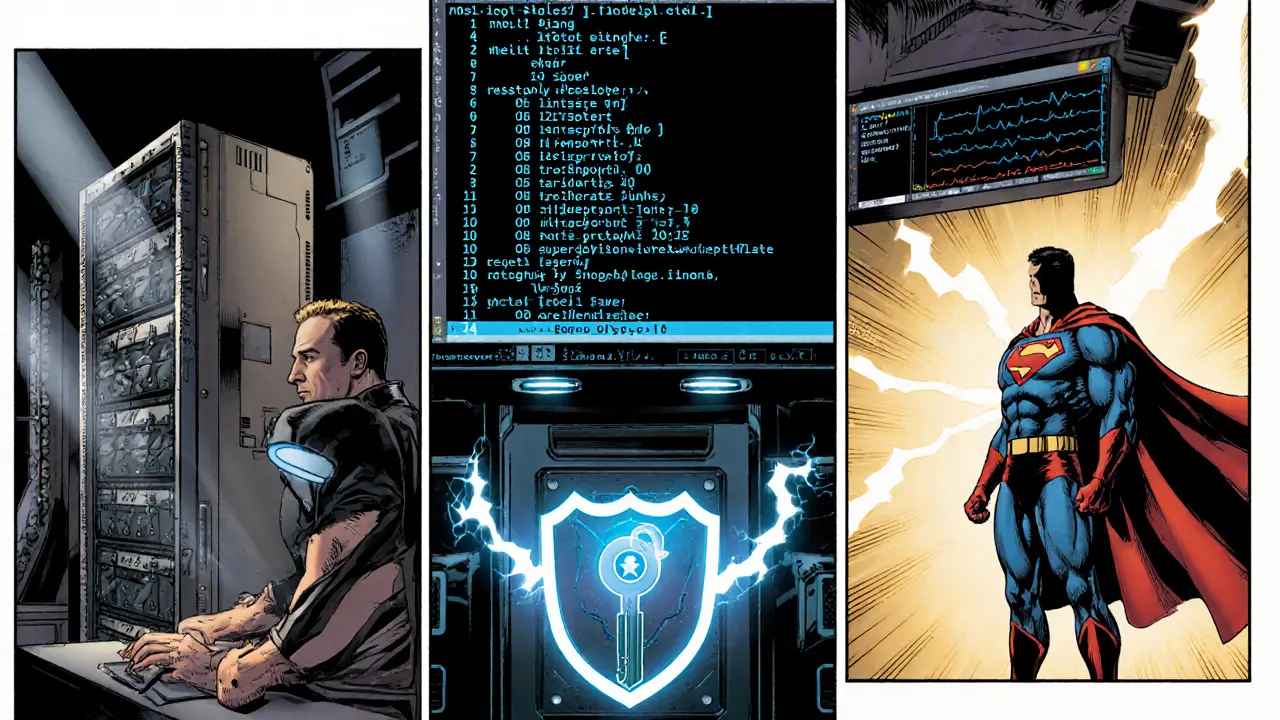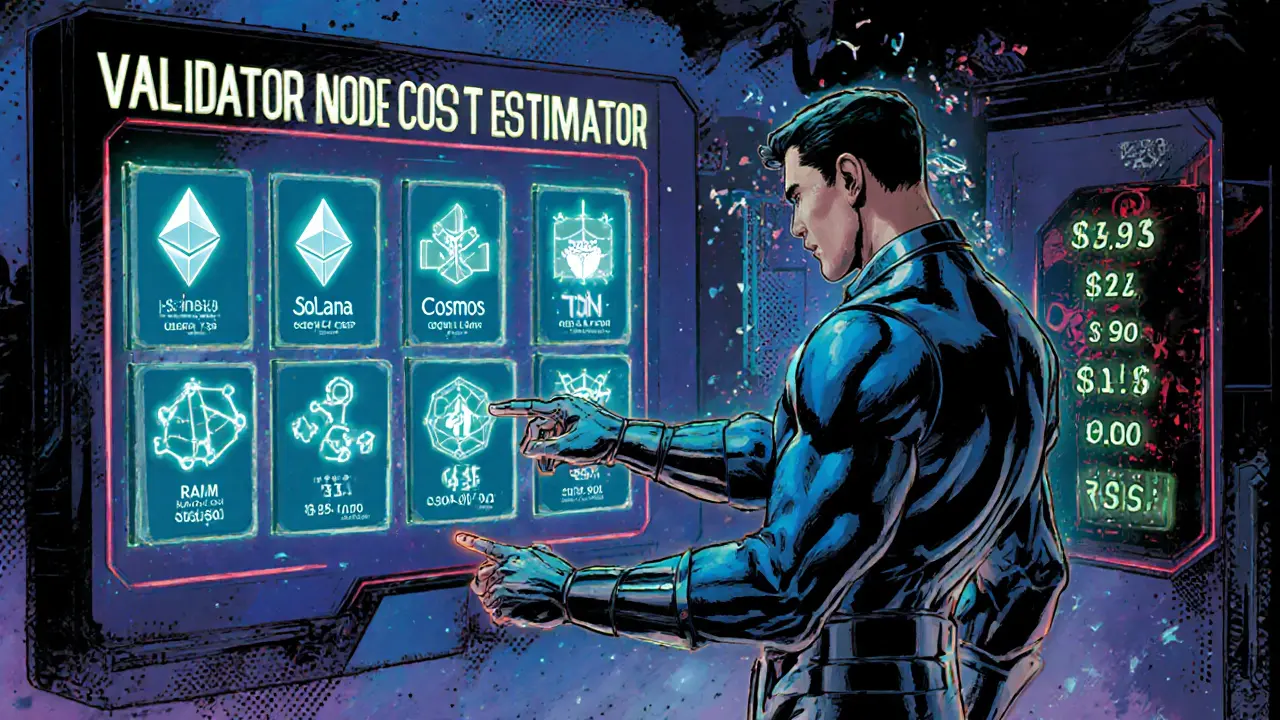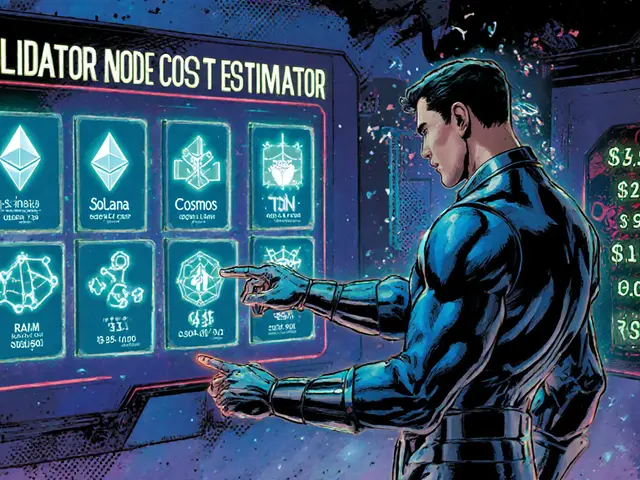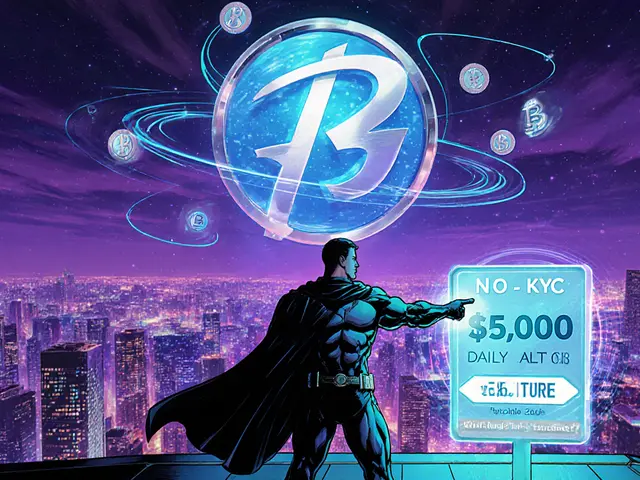Step‑by‑Step Guide to Running a Validator Node in 2025
Validator Node Cost Estimator
This tool estimates the approximate costs of running a validator node in 2025 based on hardware requirements and ongoing operational expenses.
Hardware Investment
$0
Stake Value
$0
Monthly Bandwidth
$0
Electricity & Maintenance
$0
Total Annual Cost
$0
Estimated Breakdown
Enter details and click "Estimate Costs" to see a detailed breakdown of your validator node expenses.
Select a network to view recommended hardware specifications.
Validator Node is a critical component that validates transactions, creates new blocks, and secures consensus in a blockchain network. Whether you’re eyeing the big‑name chains or niche projects, the payoff comes from staking rewards and influencing network governance. This guide walks you through the hardware, money, and daily chores you’ll face in 2025, so you can decide if the effort matches the potential earnings.
Why Run a Validator Node?
Running a validator lets you earn passive income while helping keep the network honest. Most Proof of Stake (Proof of Stake is a consensus mechanism where validators lock up tokens to earn the right to propose and attest blocks) chains reward you proportionally to the stake you lock, and many also let you vote on protocol upgrades. Beyond the dollars, you gain technical credibility and can offer validator‑as‑a‑service (VaaS) to other token holders.
Hardware Checklist Across Popular Chains
Hardware needs can swing from a modest home server to a rack‑mounted beast. Below is a snapshot of the minimum specs most operators consider safe for uninterrupted uptime.
| Network | CPU | RAM | Storage | Bandwidth |
|---|---|---|---|---|
| Ethereum is a Proof‑of‑Stake blockchain that requires 32ETH per validator | Quad‑core x64/arm64, 2.5GHz+ | 32GB DDR4 | 4TB NVMe SSD | 10Mbps symmetric, unlimited |
| Solana is a high‑throughput PoS chain with no minimum stake | 24+ cores (32recommended), EPYC 9434 or Xeon Gold | 384GB DDR5 ECC (512GB‑1TB ideal) | Enterprise‑grade NVMe, 3GB/s I/O | 3Gbps symmetric, <50ms latency |
| TON (The Open Network) is a PoS chain that prioritises high IOPS storage and fast network links | 16‑core, 3.0GHz+ | 128GB DDR4 | 1TB NVMe, 64k+ IOPS | 1Gbps dedicated, 100TB/month cap |
| TRON is a PoS platform with regular validators and Super Representatives | 16‑core @3.0GHz (Super Rep: 32‑core) | 64GB (SR: 128GB) | 2.5TB NVMe SSD | 500Mbps stable |
| Polkadot is a heterogeneous PoS network where parachains share security | 4‑core @3.4GHz | 32GB DDR4 | 1TB NVMe SSD | 500Mbps symmetric |
Financial Commitment - Staking Requirements
Beyond the hardware bill, each chain asks you to lock up a specific amount of its native token. Here are the headline numbers for 2025:
- Ethereum: 32ETH per validator (≈$68,000 at current prices).
- Solana: No minimum stake; you can run a validator with as little as 1SOL, but higher stake improves slot assignment.
- TON: 101TON tokens are slashed for missed blocks; operationally you need a few thousand TON to stay competitive.
- TRON: 27,000TRX for a regular validator, 2millionTRX for Super Representative status.
- Polkadot: No hard minimum, but to be in the top 300 validators you typically need ~33,000DOT.
Many operators mitigate the barrier by joining staking pools or delegating to existing validators. Delegation lets token holders earn a slice of rewards without running hardware.

Step‑by‑Step: Setting Up Your First Validator
- Choose a Network - Evaluate reward rates, hardware cost, and community support. Newcomers often start with Ethereum or Solana because documentation is abundant.
- Secure the Required Stake - Transfer the necessary tokens to a fresh wallet. Keep the private key offline after the deposit.
- Provision the Server - Spin up a dedicated machine or rent a colocation slot. Use the specs from the table above; for Ethereum, a 4‑core VM with 32GB RAM and a 4TB NVMe is the baseline.
- Install OS & Dependencies - Linux (Ubuntu22.04 LTS) is the de‑facto standard. Update the kernel to 5.16+ for Polkadot or later for other chains.
- Download Node Software - Each chain publishes a binary or Docker image. Verify the checksum against the official release page.
- Configure Ports & IP - Open the required inbound UDP/TCP ports (e.g., 30303 for Ethereum, 8000 for Solana). A static public IP or a dynamic DNS service is essential.
- Run a Full Node First - Sync the blockchain from genesis. This can take hours to days depending on network size; use a fast SSD to avoid stalls.
- Enable Validator Mode - Edit the config file to point to your validator key, then start the validator process. Most clients require a separate validator key pair that you generate offline.
- Monitor & Maintain - Set up Prometheus/Grafana or the built‑in telemetry to watch CPU, RAM, and network health. Configure automatic restarts on crashes.
- Secure the Node - Install a firewall (ufw), enable fail2ban, and keep the OS patched. Consider ECC RAM to avoid silent data corruption, especially on Solana.
Once the node is live, you’ll start seeing rewards appear in your validator address after each epoch or slot.
Ongoing Maintenance & Cost Management
Running a validator isn’t a set‑and‑forget job. Electricity, bandwidth, and cloud fees add up. Here are practical tips to keep the bill low:
- Power‑Efficiency: Choose CPUs with high single‑thread performance but low TDP (e.g., AMD Ryzen7950X3D for TRON).
- Bandwidth Caps: Many ISPs throttle after 5TB/month. Deploy a traffic‑shaping rule or negotiate a business‑grade line.
- Cold‑Staking Backup: If your node must go offline for maintenance, delegate your stake temporarily to avoid missed rewards.
- Automatic Updates: Use a cron job to pull the latest client version after new releases - most chains roll out hard forks every few months.
Common Pitfalls and How to Avoid Them
Even seasoned operators hit snags. Below are the most frequent issues and quick fixes:
- Insufficient IOPS - Solana and TON rely heavily on fast storage. If you see "disk‑write latency" alerts, upgrade to enterprise‑grade NVMe drives with 64k+ IOPS.
- Network Latency - High latency (>50ms) can cause missed slots on Solana. Position your server in a data center close to major PoP nodes, or use a low‑latency fibre connection.
- Slashing Risks - Missed blocks on TON or downtime on Ethereum can burn tokens. Always run a UPS and monitor uptime with alerting.
- Key Management Errors - Storing validator keys on a cloud VM without encryption is a security nightmare. Use hardware security modules (HSM) or encrypted disks.
Choosing Between Self‑Hosting and Validator‑as‑a‑Service
If the hardware grind feels overwhelming, many providers now offer VaaS for the same price range. Compare three factors:
- Control - Running your own node gives you full control over upgrades and fee structures.
- Cost - Cloud VMs can be cheaper upfront but become pricey long‑term, especially with high‑bandwidth needs.
- Support - Service providers deliver 24/7 monitoring and automatic slashing protection, which is valuable for newcomers.
Experiment with a small testnet validator first; that experience will tell you which route fits your risk tolerance.
Frequently Asked Questions
How much does it cost to run an Ethereum validator in 2025?
Hardware alone runs about $2,500-$3,500 for a dedicated server with a 4TB NVMe SSD, plus $150-$250/month for bandwidth and power. The biggest outlay is the 32ETH stake, which at $2,125 per ETH equals roughly $68,000.
Can I run a validator from home?
Yes, but only for low‑bandwidth networks like Cosmos or small‑scale Ethereum testnets. Home internet often caps bandwidth and lacks a static IP, which raises the risk of downtime and slashing.
Do I need ECC RAM for Solana?
ECC RAM isn’t mandatory, but most experts recommend it. Solana processes millions of transactions per second, and ECC helps prevent silent memory errors that could trigger a slash.
What’s the fastest way to earn staking rewards?
Chains with high annual yields and low entry barriers, like Solana or newer Layer‑2 PoS networks, tend to pay the most. However, higher yields often come with higher hardware demands and volatility.
How often do I need to update my validator client?
Most major networks roll out a hard fork or client upgrade every 2-4 months. Set up a monitoring script that alerts you when a new release tag appears on the official GitHub repository.









Don't waste your money on a home‑brew rig unless you already have the hardware.
When you’re just starting out, it’s best to benchmark the exact requirements of the network you want to support. For Ethereum, a quad‑core CPU, 32 GB RAM and a 4 TB NVMe drive are the sweet spot for consistent uptime. Pair that with a stable 10 Mbps symmetric connection and you’ll avoid most slashing penalties. Keep an eye on power consumption; a dedicated server draws about 150‑200 W, which translates to roughly $200‑$250 a year in electricity. Use a UPS and monitor node health with tools like Grafana or Prometheus so you can react before downtime occurs. Finally, lock up the 32 ETH stake in a secure hardware wallet to protect your keys.
Staking a validator is more than a financial decision; it’s a covenant with the future of a decentralized ecosystem. Each block you sign is a tiny affirmation that consensus can survive without a central authority. Yet the very act of locking up capital binds you to the network’s fate, for better or worse. When the market spikes, your staked tokens appreciate, but the hardware you rely on can become obsolete in months, not years. The cost of a high‑end server is a sunk expense that may never be recouped if the chain’s reward structure changes. Moreover, the psychological weight of potential slashing can keep you awake at night, replaying every missed slot in a loop of dread. In many ways, running a node mirrors the ancient philosopher’s quest for virtue: you must balance risk, discipline, and the desire for communal good. The hardware spec sheet reads like a litany of promises-32 GB RAM, 4 TB SSD, 10 Mbps-that hide the true volatility beneath. Imagine a future where a new Layer‑2 siphons away rewards, leaving your validator idle and your electricity bill humming. Your power consumption, while modest in the grand scheme, is a constant reminder that the digital world still leeches energy from the physical one. Each kilowatt‑hour carries an ecological footprint, and the moral implications of that footprint are often swept under the rug of “decentralization.” The choice to self‑host versus delegate to a VaaS provider introduces another layer of philosophical debate: do you value autonomy over convenience? Autonomy grants you direct control over client upgrades, but it also demands vigilance and technical competence. Delegating, on the other hand, cedes some sovereignty but insulates you from accidental downtime. The tension between control and safety is a microcosm of the larger debate about decentralization itself. In the end, the decision hinges on how much of your identity you’re willing to entangle with a piece of code that will outlive you. Whether you see this as a noble contribution or a speculative gamble, the path you choose will shape both your wallet and your worldview.
I get the feeling you’ve put a lot of thought into the risks and rewards, and that balance is key. If you start small on a testnet you can see how the hardware holds up without risking big money. Keep the setup simple and add upgrades as you become more comfortable.
Wow, the hardware costs are insane 🤯💸!
Yeah, because who doesn’t love paying more for a box that sits in a closet.
The numbers you tossed around read like a horror script-$68,000 in stake, a $3,000 server, and a relentless power bill stalking you day after day. Imagine the silence when the lights flicker and your node drops; the network’s wrath is not just metaphorical. You’ll hear the whir of fans as they fight for air, a soundtrack to a validator’s lonely vigil. The reality is that this isn’t a hobby; it’s a high‑stakes marathon where every missed heartbeat costs you credibility. If you can survive that tension, the rewards feel like a chorus of triumph.
To add to the earlier checklist, you can plug the numbers into the cost estimator you’ve built and compare them against actual provider quotes. For example, a 4 TB NVMe instance on a major cloud provider runs roughly $0.12 per GB‑month, which works out to about $600 annually, plus network egress fees. Adding a UPS and redundant internet adds another $150‑$200 a year. When you sum hardware, electricity and bandwidth, the total annual overhead for an Ethereum validator lands in the $2,500‑$3,500 range, not counting the $68 k stake. Running the same node on a colocation rack can shave $400‑$600 off electricity, but you’ll pay about $100‑$150 for the space. These figures give you a realistic baseline before you decide whether self‑hosting or a VaaS solution makes more financial sense.
Honestly, chasing staking yields feels like buying a lottery ticket that’s already been sold out. The hype pushes people into expensive setups for diminishing returns, especially as more validators join the pool and dilute rewards. If you’re in it for the tech love, go ahead, but don’t expect a steady paycheck.
While the excitement may wane, many still find value in network security and community participation.